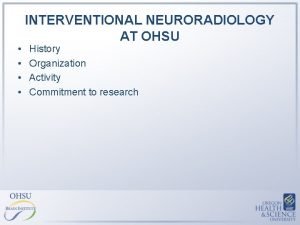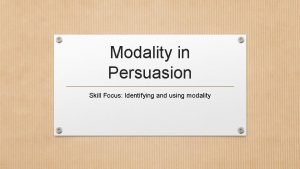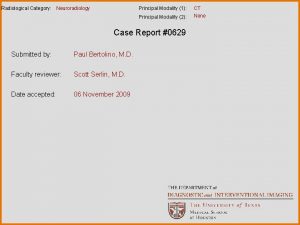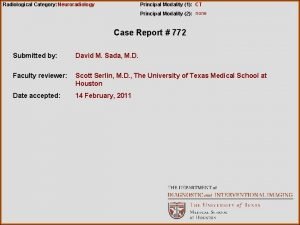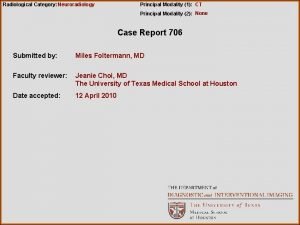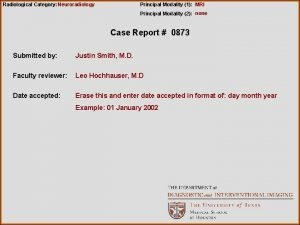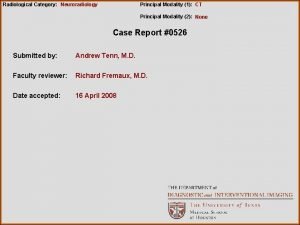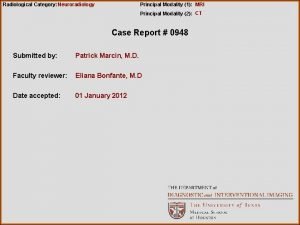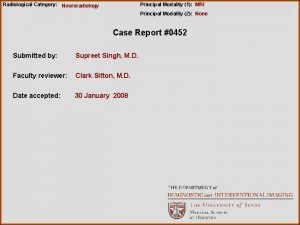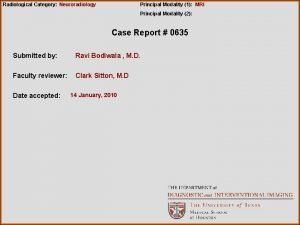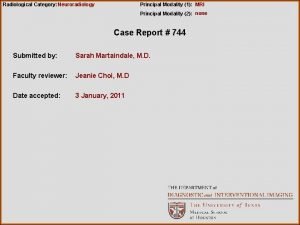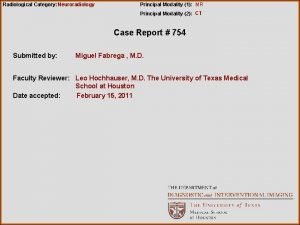Radiological Category Neuroradiology Principal Modality 1 General Radiography













- Slides: 13

Radiological Category: Neuroradiology Principal Modality (1): General Radiography Principal Modality (2): MRI with and without contrast Case Report #0162 Submitted by: Armando Saenz, M. D. Faculty reviewer: Leo Hochhauser, M. D. Date accepted: January 10, 2005

Case History 62 y. o. female with weight loss and back pain.

Radiological Presentations

Radiological Presentations

Radiological Presentations

Radiological Presentations

Radiological Presentations

Test Your Diagnosis Which one of the following is your choice for the appropriate diagnosis? After your selection, go to next page. • Malignant neoplasm • Discitis • Severe osteoporosis

Findings and Differentials Findings: The L 4 -5 disc space is narrow and shows increased T 2 signal intensity within the disc. There is erosion of the inferior L 4 and superior L 5 end plates with enhancement of the associated vertebral bodies after contrast. The paravertebral soft tissues enhance and extend through the foramina into the epidural space compressing thecal sac. Differentials: • Discitis with associated osteomyelitis and intraspinal extension • Intraspinal abscess extending into the vertebral bodies

Discussion • Discitis is an inflammatory lesion of the intervertebral disc that occurs more commonly in children than adults. It is believed to be caused by a low grade infection that affects the disc space. The infection probably begins in one of the contiguous endplates, and the disc is infected secondarily. Severe back pain that begins insidiously is characteristic of the disease. • Patients with discitis may not be systemically ill. The disease may or may not be associated with fever, leukocytosis, chills, sweats, loss of appetite and fatigue. The ESR is typically elevated. Lateral radiographs of the spine will usually reveal disc space narrowing and erosion of the vertebral endplates of the contiguous vertebrae. Bone scans may localize a lesion that is difficult to diagnose clinically. However, false negative bone scans do occur and a normal bone scan result therefore does not exclude a disc space infection. Magnetic resonance imaging (MRI) is helpful.

Discussion • The appropriate treatment of these lesions has been the subject of controversy. Most authors recommend plaster cast immobilization, a treatment that seems to be effective by itself in many cases. Some authors think that antibiotics also should be given because the condition most likely is an infection of the disc, frequently caused by Staphylococcus aureus. In treating the lesion in children, a biopsy is usually not necessary. In adolescents and adults, however, a biopsy may be indicated especially in the setting of drug abuse as this may involve different infectious organisms.

References Brandt W. , Helms C. , Fundamentals of Diagnostic Radiology Second Edition. Lippincott, 1999. Grossman R. , and Yousem D. , The Requisites Neuroradiology Second Edition. Mosby, 2003. Dahnert W. , Radiology Review Manual Fourth Edition. Lippincott, 2000.

Diagnosis Changes consistent with L 4 -5 DISCITIS. Inflammatory changes extend into the vertebral bodies, paravertebral, and epidural regions compressing thecal sac. CT guided biopsy with aspiration for culture is recommended.
 Ohsu neuroradiology
Ohsu neuroradiology Aerohive erate
Aerohive erate Tennessee division of radiological health
Tennessee division of radiological health Center for devices and radiological health
Center for devices and radiological health National radiological emergency preparedness conference
National radiological emergency preparedness conference Radiological dispersal device
Radiological dispersal device Data modeling fundamentals
Data modeling fundamentals Lexical vs auxiliary verbs
Lexical vs auxiliary verbs Skill focus: persuasion
Skill focus: persuasion Pacs modality workstation
Pacs modality workstation Diplode
Diplode Sensory vs somatic
Sensory vs somatic Epistemic modality
Epistemic modality Sodality vs modality
Sodality vs modality
